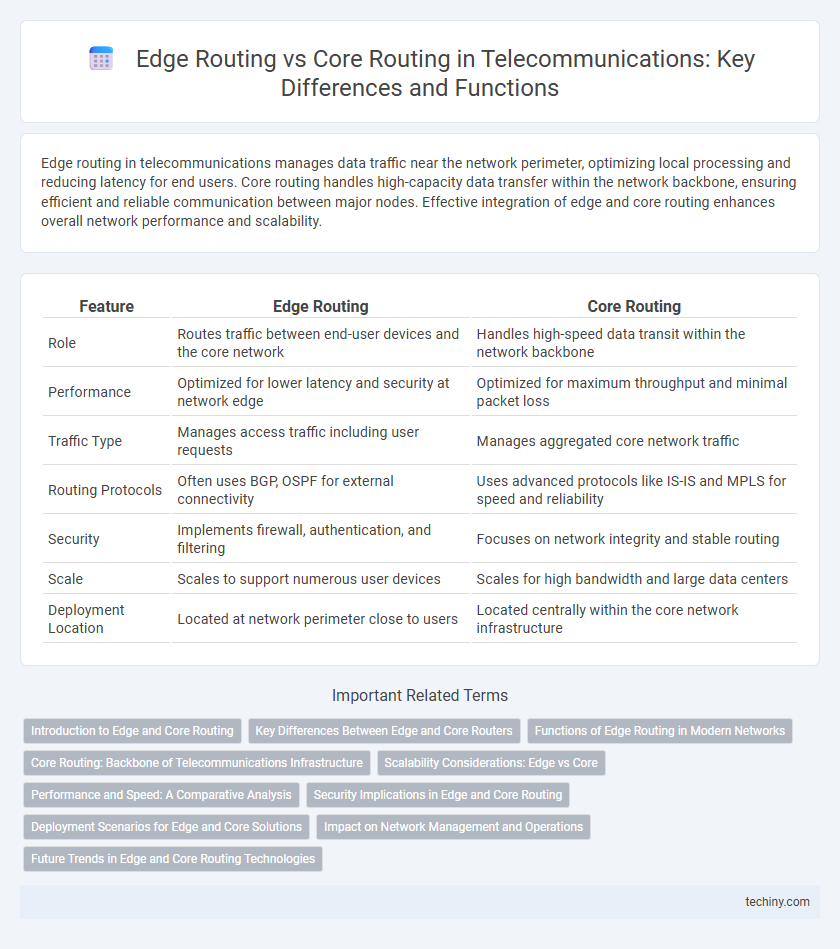Edge routing in telecommunications manages data traffic near the network perimeter, optimizing local processing and reducing latency for end users. Core routing handles high-capacity data transfer within the network backbone, ensuring efficient and reliable communication between major nodes. Effective integration of edge and core routing enhances overall network performance and scalability.
Table of Comparison
| Feature | Edge Routing | Core Routing |
|---|---|---|
| Role | Routes traffic between end-user devices and the core network | Handles high-speed data transit within the network backbone |
| Performance | Optimized for lower latency and security at network edge | Optimized for maximum throughput and minimal packet loss |
| Traffic Type | Manages access traffic including user requests | Manages aggregated core network traffic |
| Routing Protocols | Often uses BGP, OSPF for external connectivity | Uses advanced protocols like IS-IS and MPLS for speed and reliability |
| Security | Implements firewall, authentication, and filtering | Focuses on network integrity and stable routing |
| Scale | Scales to support numerous user devices | Scales for high bandwidth and large data centers |
| Deployment Location | Located at network perimeter close to users | Located centrally within the core network infrastructure |
Introduction to Edge and Core Routing
Edge routing directs data traffic at the network's perimeter, handling user access, traffic aggregation, and initial packet processing to optimize latency and bandwidth efficiency. Core routing operates within the network backbone, ensuring high-speed, reliable data transmission between edge routers using robust protocols and scalable infrastructure. Together, edge and core routing form a hierarchical system that balances localized traffic management with long-distance data transport.
Key Differences Between Edge and Core Routers
Edge routers manage data traffic between a service provider's network and external networks, optimizing for traffic filtering, security, and routing policies at network boundaries. Core routers handle high-speed data transmission within the backbone of the network, focusing on efficient packet forwarding, scalability, and minimal latency across the network core. While edge routers interface with varied external protocols, core routers prioritize high throughput and reliability to maintain seamless internal network connectivity.
Functions of Edge Routing in Modern Networks
Edge routing in modern telecommunications networks primarily manages data traffic between local networks and the core network, optimizing latency and bandwidth usage. It performs crucial functions such as traffic filtering, Quality of Service (QoS) enforcement, and protocol translation, enhancing network efficiency and security. By handling tasks like packet inspection and traffic shaping, edge routers reduce the load on core routers and support seamless connectivity for end-user devices.
Core Routing: Backbone of Telecommunications Infrastructure
Core routing serves as the backbone of telecommunications infrastructure by managing high-capacity data transfer between major network nodes and ensuring efficient traffic flow across long distances. It handles large-scale routing tables and supports protocols like MPLS (Multiprotocol Label Switching) for optimized packet forwarding, enabling seamless connectivity and low latency across the global network. Unlike edge routing, core routers prioritize speed, scalability, and robustness to maintain the integrity and performance of the entire telecommunications backbone.
Scalability Considerations: Edge vs Core
Edge routing enhances scalability by distributing traffic processing closer to end-users, reducing latency and network congestion. Core routing, designed for high-capacity backbone transport, manages aggregated data flows with robust hardware but faces bottlenecks when scaling to meet rapid traffic growth. Efficient scalability in telecommunications networks leverages edge routing to offload traffic and core routing for optimized long-haul data transmission.
Performance and Speed: A Comparative Analysis
Edge routing enhances performance and speed by processing data closer to the source, reducing latency and bandwidth demand on the network core. Core routing, designed for high-capacity, long-distance data transmission, excels in stability and centralized traffic management but may introduce delays due to longer data paths. The comparative efficiency hinges on use-case requirements, with edge routing offering superior responsiveness for real-time applications and core routing providing robust throughput for large-scale data flows.
Security Implications in Edge and Core Routing
Edge routing primarily handles data at the network's periphery, where it faces heightened exposure to external threats such as DDoS attacks and unauthorized access, necessitating robust security measures like firewall integration and real-time traffic analysis. Core routing manages data within the secured backbone of the network, focusing on high-speed data transfer with fewer direct attack vectors but requiring strong encryption and resilient routing protocols to prevent internal breaches and ensure data integrity. Implementing layered security strategies tailored to edge and core routing environments is critical for maintaining comprehensive protection across the telecommunications infrastructure.
Deployment Scenarios for Edge and Core Solutions
Edge routing is deployed closer to end-users and IoT devices, optimizing latency-sensitive applications and local data processing in telecommunications networks. Core routing solutions focus on high-capacity, long-haul data transport and centralized traffic management, supporting backbone infrastructure with robust redundancy and scalability. Deployment scenarios for edge routing prioritize distributed network architectures, while core routing emphasizes centralized, high-throughput routing environments.
Impact on Network Management and Operations
Edge routing significantly influences network management by decentralizing traffic control, enabling localized decision-making and improving fault isolation, which reduces operational complexity at the core. Core routing centralizes high-speed data aggregation and long-haul traffic management, demanding robust protocol configurations and comprehensive monitoring to maintain overall network stability. Efficient coordination between edge and core routing enhances scalability, optimizes resource allocation, and accelerates troubleshooting processes in telecommunications networks.
Future Trends in Edge and Core Routing Technologies
Future trends in telecommunications emphasize edge routing advancements with AI-powered traffic management and enhanced security protocols to handle increasing IoT and 5G data loads. Core routing technologies are evolving towards quantum-safe encryption and high-capacity optical transport to support ultra-low latency and massive bandwidth demands. Integration of software-defined networking (SDN) and network function virtualization (NFV) across both edge and core routing infrastructures drives dynamic scalability and improved network intelligence.
edge routing vs core routing Infographic

 techiny.com
techiny.com